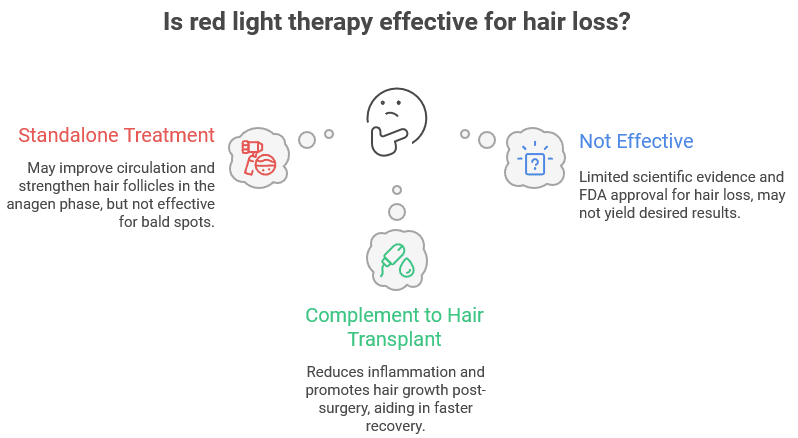There’s always a lot of motivation to find unique new treatments for male and female pattern baldness. These conditions affect around half the global population in the 30–50 age bracket, and can be devastating to a person’s confidence. Red light therapy is the latest potential answer to this problem, as it has shown lots of potential in helping various tissues heal after surgery.
Today, we will explore the science behind this treatment and talk about its effectiveness when used by itself or when combined with tried-and-true methods like hair transplants.
Did you know?
Hair loss is a widespread issue — in fact, studies show that approximately 50% of men and up to 40% of women experience noticeable hair loss by the age of 50
What Is Red Light Therapy?
This technique has been around for a while, first used by dermatologists to combat Stage 1 skin cancer along with other interventions, but was soon adopted by the beauty industry. Special medical devices are used to generate specific wavelengths of red light, 630 nm and 660 nm, that can penetrate the surface of the skin and cause blood vessels in the area to dilate.
Because it brings increased blood flow to the cells, red light therapy (RLT) has shown promising results as a non-invasive way to iron out wrinkles around the eyes and the forehead.
Some studies also demonstrated that it could help in the early stages of the healing process after plastic surgery. It was then a logical jump to try it out as both a standalone hair loss treatment and as a way to speed up healing after hair transplant operations.
Red Light Therapy for Hair Loss: How It Works
The main benefit of this treatment for people with thinning hair is that it can improve circulation, thus getting more nutrient-rich blood to hair follicles and strengthening them. However, it will only have this effect if the follicles are in the anagen phase, i.e., if the strands are actively growing.
However, if you have bald spots on the top of the head or a heavily receded hairline, you won’t see an improvement. That’s because red light cannot stimulate hair growth if the cells in the roots are already dead.

Red Light Therapy vs. LLLT vs. LED Devices
To find out what the most effective options are for men and women suffering from hair loss, we will compare the effects of red light, LED, and low-level light therapy (LLLT), and what science has to say about each one.
Factor | Red Light | Low-level light therapy | LED Devices |
Light Source | Broad-spectrum red light (600–700 nm) | Coherent laser light ( 650–680 nm) | Non-coherent LEDs (630–670 nm) |
Penetration Depth | Moderate | Deepest | Shallow–moderate |
Evidence Strength | Moderate (some studies show improved density) | Strongest (FDA-cleared devices, multiple clinical trials) | Moderate–low (mixed results, fewer trials) |
Effectiveness | Can improve hair thickness and slow shedding | Effectively stimulates follicles and promotes regrowth | May support maintenance |
Cost | Moderate | High (medical-grade devices are expensive) | Low–moderate |
Scientific Evidence: What the Research Says
While the FDA has approved a number of low-level laser therapy devices for use in male and female pattern hair loss, also known as androgenetic alopecia, it hasn’t yet done so for red light. There are also currently only a few studies showing a link between RLT and improved hair thickness and growth.
However, there is a solid amount of evidence pointing to its effectiveness as a vasodilator, and since that’s how Minoxidil, a popular hair loss drug cleared by the FDA, works, you could expect similar results.
RLT as a Complement to Hair Transplant Surgery
Here is where we get to the real winning combination. Red light therapy is commonly used after a FUE or DHI hair transplant in Turkey to reduce inflammation during the first week after the operation. It may also promote more hair growth in the upcoming months, after the initial shedding.
That way, you can get back to your normal routine a bit faster and strengthen the existing strands around the recipient area, helping cover up the signs of the operation until the new hair grows out.
Safety, Risks, and Side Effects
Being a non-invasive method, RLT doesn’t have much in the way of adverse effects that you need to worry about. In fact, there are several clinically tested devices that have been cleared for medical use by the FDA. These generally only create a feeling of mild heat in the area being treated, and sometimes a light tingling sensation coupled with redness, which typically goes away within a few hours or a day.
In terms of risks, the only real issue you may have is if your eyes are exposed to the light, which can damage the retina, but if you wear protective goggles and follow the doctor’s instructions, you should be completely fine.
FAQs
Can red light therapy improve hair transplant results?
Although it can’t substitute FUE or DHI surgery for treating hair loss, RLT can definitely help with the recovery. It boosts blood flow to the donor follicles, which helps them strengthen, and it can also lead to a denser overall look.
How soon after a hair transplant can I use RLT?
Some clinics will recommend waiting for a bit, until the incisions have closed up and the grafts have taken root. The specific timeframe may vary on a case-by-case basis, but it’s usually somewhere around five to seven days. Before that, the area will be too sensitive, and any direct light exposure could be counterproductive.
Can it replace the need for a transplant?
Unfortunately, RLT doesn’t directly cause hair regrowth and will simply not be able to bring damaged or dead follicles back to life. That’s why it can only be used as a helpful addition to a classic transplant, not a replacement.
Is it safe to use with minoxidil or finasteride?
It is considered perfectly safe. These are both well-studied drugs that have been proven to improve hair health, stopping further thinning and even causing some new growth with no negative interactions with RLT.
In fact, there is some evidence suggesting that this combination can offer even better results. However, always get RLT before applying a topical minoxidil cream, but if you are taking pills, the order isn’t important.

